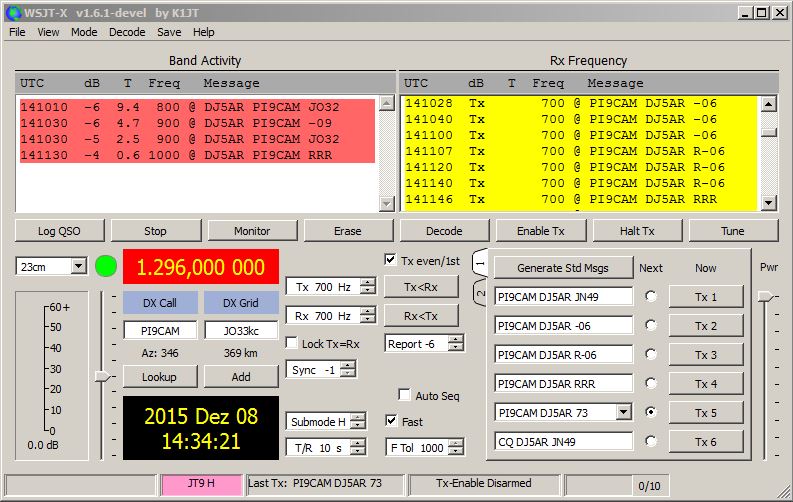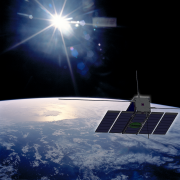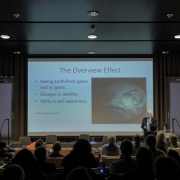Eerste amateurradioverbinding via satelliet vanuit Dwingeloo
Na bijna twee jaar proberen is het ons CAMRAS EME-team gelukt om op 8 december een heel bijzondere “first” te maken: de eerste amateurradioverbinding ter wereld via reflectie tegen een kleine satelliet. Deze satelliet bounce QSO is in de 23 cm band gemaakt tussen PI9CAM (de Dwingeloo Telescoop) en DJ5AR (Andreas Imse in Mainz met een 3 meter schotel). De satelliet werd dus gebruikt als een passieve reflector. De razendsnel voorbij vliegende satelliet gaf ons net voldoende tijd voor een verbinding en veroorzaakte natuurlijk een enorme Dopplerverschuiving.
Dat kon alleen maar lukken dankzij de nieuwe communicatiemode JT9H (een negen-toons-systeem) dat onderdeel uitmaakt van de nieuwe WSJT-X software van Joe Taylor. De Dopplerverschuiving (+/- 60 kHz) werd aan de kant van DJ5AR automatisch met behulp van de computer gecorrigeerd.
De satelliet was de OKEAN-O (NORAD#25860), een niet meer gebruikte Russisch-Oekraïense Aardobservatie satelliet met een polaire baan van ongeveer 650 km hoogte en een reflectieoppervlak van ongeveer 20 vierkante meter.
In twee blogs schrijft Andreas Imse:
1 – A new Chapter in the Book of Bounce (2015-12-08)
While ISS Bounce took Jan, PA3FXB, and me 2 months of testing and improving to succeed, Satellite Bounce was a much bigger challenge. Despite the fact, Jan and the team of PI9CAM are operating the 25 m dish of the Dwingeloo radio telescope, it took us nearly 2 years, enormous patience and scores of tests until we finally managed to receive “Rs” to complete a QSO today (December 8th, 2015). As far as we know, it is the first time ever, a two way amateur radio contact could be completed by using an unmanned spacecraft as a reflector.
Above screenshot shows the position of the satellite at the end of the QSO. The Satellite rose in SSE and set in NNW. A calculative common window opened at the point, marked “O”. Local obstructions were not considered. Due to safety reasons transmissions in Dwingeloo are limited to elevations above 10°. So the AOS (acquisition of signal) happend shortly before the groundtrack of the Satellite crossed the 40th degree of latitude northwards, as soon as PI9CAM started transmissions. Sum of slant ranges (distance between ground station and satellite) was 3400 km at the beginning and 2000 km at the end of the contact.
Much of the reflections remained below the noise floor, but this one of PI9CAM, right at the beginning (14:10:10 UTC), is a nice example, of what can be received:
And vice versa DJ5AR as to be heard in Dwingeloo (14:11:00 UTC):
The used object OKEAN-O (NORAD #25860) is a joint Russian-Ukrainian Earth observation satellite, launched on July 17th, 1999 by an Ukrainian Zenit-2 carrier rocket. The satellite is in a polar orbit of about 650 km height with an inclination of 98°. The mass is 6.2 tons and the RCS (radar cross section) is figured between18 and 20 m². It has been used for research of natural resources, ecological monitoring and hazards prevention. Designed for a life time of 3 years, it is out of service now.
In use by the ground stations were the 25 m radio telescope in Dwingeloo by PI9CAM with 120 W and a 3 m dish with 150 W at the feed by DJ5AR in Mainz. The mode used was digital JT9H that comes with the new WSJT-X software by Joe Taylor, K1JT. The transmit/receive periods were set to 10 seconds, working around a center frequency of 1296.300 MHz. The automated Doppler tracking (+/- 60 kHz) has been performed for the complete path on DJ5AR´s side with a homebrew tracking software. The calculative power budget during the QSO was about -154 dBm. This value is very optimistic, as it presumes the optimum reflectivity of the satellite, which depends on its orientation.
Conclusion: The main difficulties in this game are:
- Selection of suitable satellites, depending on radar cross sections and slant ranges.
- Compensation of the Doppler shift with a maximum rate of 600 Hz/second.
- Antenna tracking with dish of a mass of 120 tons.
To be continued…
2 – QSL for first Satellite Bounce by Amateurs arrived today (2015-12-23)
Today PI9CAM´s QSL for the first Satellite Bounce QSO via an unmanned spacecraft done by radio amateurs arrived by mail. As we know, there have been previous commercial attempts for Satellite Bounce in the early 60s using ECHO 1 and ECHO 2 which were inflated balloons with diameters of 30 and 41 m. The initial orbits were at heights of 1500 km and 1200 km.The theoretical radar cross section (RCS) of ECHO 1 was 700 m², but measurements by military radar stations resulted in 900 to 1000 m² in the beginning. Later, the satellite deformed and shrunk. OKEAN-O, the one we used, has a radar cross section of 18 to 20 m² but is in a much lower orbit at a height of 650 km. This leads to quite similar unit power budgets, regardless the difference in size.














